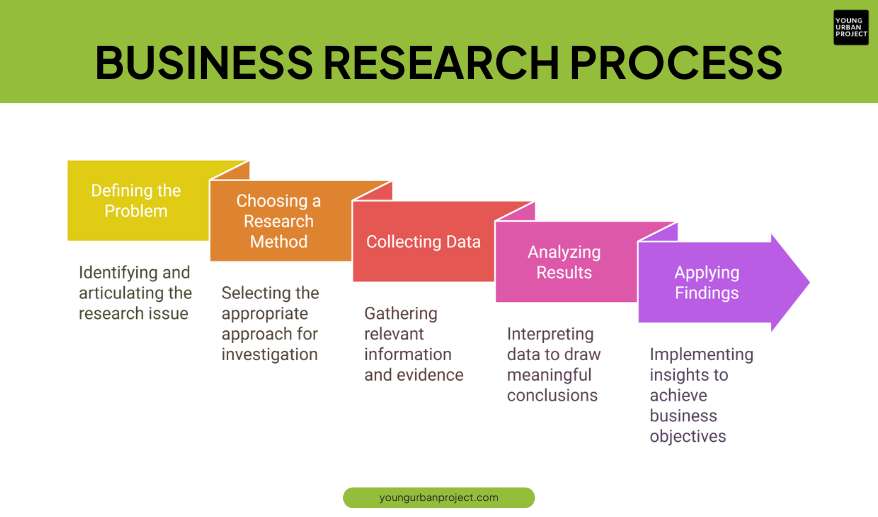How do companies decide what products to launch, which markets to enter, or how to price their offerings? They don’t just rely on gut feelings or guesswork. Instead, they use different types of business research to gather data, spot trends, and make smart decisions.
Table of Contents
Understanding these research methods is super helpful for any business trying to succeed in a competitive market. So, let’s break it down and see what types of business research companies use and how they work!
What is Business Research? 🤔
Business research is all about gathering information to understand markets, customers, competitors, and industry trends. This research helps companies make smarter decisions about their products, pricing, marketing, and operations.
The process usually involves five main steps:

- Defining the problem: What do you need to know?
- Choosing a research method: How will you collect the data?
- Collecting data: Getting the info you need.
- Analyzing results: What do the numbers say?
- Applying findings: Using the data to make better decisions.
When done right, business research can seriously help a company grow and succeed. Let’s dive into the two main types of business research: quantitative and qualitative.
Types of Business Research
Business research is broadly classified into two categories: quantitative research and qualitative research. These categories are further divided into various business research methods, each designed to gather different types of data and insights. Let’s dive deep into each type of business research and explore its significance, applications, advantages, and challenges.
A. Quantitative Research Methods: Numbers, Stats, and Hard Data 📊
Quantitative research is all about numbers. This research gives companies solid, measurable data to help them make decisions backed by facts. Here are some popular types of quantitative research methods:

1. Survey Research
Survey research is one of the most common types of business research. It involves asking a lot of people specific questions to gather data.
How it works: A researcher designs questions to get answers about things like customer satisfaction, market trends, or product preferences. The surveys can be sent out online, via email, or even in person.
Why it’s used: Companies use surveys to get feedback from customers, employees, and test new product ideas.
Pros: Surveys are easy to set up, cost-effective, and can gather a lot of data quickly.
Cons: Sometimes people don’t answer honestly, and survey fatigue can make results less reliable.
2. Correlational Research
Correlational research looks at how two or more things are related, but it doesn’t show a cause-and-effect relationship.
How it works: It looks at past data (like sales or customer behavior) to see if there’s a pattern. For example, if more ads lead to higher sales, this would be a correlation.
Why it’s used: Companies use this to spot trends, like how much money they should spend on advertising.
Pros: Helps predict future trends and understand patterns.
Cons: Just because two things happen together doesn’t mean one causes the other.
3. Causal-Comparative Research
This type of research looks at how one thing affects another, without doing experiments.
How it works: Researchers look at existing data to see if differences between two groups might have caused a certain outcome.
Why it’s used: It helps compare groups and see what impacts things like customer retention or product success.
Pros: You don’t need to set up expensive experiments.
Cons: There might be other factors influencing the results that you can’t control.
4. Experimental Research
Experimental research is the most detailed and accurate way to find out cause-and-effect relationships.
How it works: In an experiment, one group gets a change (like a new product feature), while another group stays the same. By comparing the results, researchers can figure out what worked.
Why it’s used: Companies use this to test new product features, pricing strategies, or marketing campaigns.
Pros: You get clear, evidence-based results.
Cons: It can be expensive and time-consuming.
5. Online or Literature Research
This method involves looking at existing research from reports, studies, and articles.
How it works: Companies study market reports, research papers, and even their competitors to find trends and insights.
Why it’s used: It helps businesses learn about their industry and competitors without starting from scratch.
Pros: It’s cheap and saves time.
Cons: The data might be old or not totally relevant to the current situation.
Also read: Business Research Methods
B. Qualitative Research Methods 💬
While quantitative research is all about numbers, qualitative research focuses on understanding people’s thoughts, behaviors, and motivations. Here’s a look at some popular qualitative methods:

1. Interviews
Interviews are personal conversations where researchers ask questions to get deeper insights.
How it works: Researchers can ask set questions (structured), or have flexible discussions (semi-structured or unstructured).
Why it’s used: Companies use interviews to understand how customers feel about their products or services.
Pros: You get to dig deep into people’s thoughts and experiences.
Cons: Interviews can take a lot of time, and the interviewer’s biases might affect the answers.
2. Focus Groups
Focus groups involve a small group of people who share their opinions on a topic.
How it works: A moderator leads the group, asking open-ended questions and encouraging discussion.
Why it’s used: Focus groups are great for testing new product ideas or getting feedback on marketing strategies.
Pros: You get a variety of opinions in one sitting.
Cons: Some people might dominate the conversation, making it less balanced.
3. Ethnographic Research
Ethnographic research means spending time in a community or with customers to see their behavior in real life.
How it works: Researchers watch people interact with products, or observe behavior in stores, offices, or online.
Why it’s used: This method helps companies understand customer needs and behaviors that might not come out in surveys.
Pros: Gives a real-life view of how people behave.
Cons: It’s very time-consuming and could be influenced by the researcher’s own views.
4. Case Study Research
Case studies are in-depth looks at one business, product, or event to understand what worked (or didn’t work).
How it works: A company studies its own successes and failures to find valuable lessons.
Why it’s used: It’s a great way to learn from real examples in the business world.
Pros: You get deep insights that you can apply to your own business.
Cons: The results might not apply to every situation or business.
5. Website Visitor Profiling/Research
This method looks at how people use a company’s website to understand their behavior online.
How it works: Businesses track how visitors interact with their websites using analytics tools.
Why it’s used: This helps improve website design, user experience (UX), and digital marketing strategies.
Pros: It gives real-time data about what people are doing on your site.
Cons: It requires good knowledge of web analytics tools to interpret the data.
By using these research methods, businesses can make smarter decisions that drive growth. Whether it’s through surveys, interviews, or deep dives into data, the right research can help companies understand their customers and market, making them more competitive and successful in the long run.
So, if you’re looking to improve your business, start using research. It might take some effort, but the rewards are totally worth it!
Also read: The Scope of Business Research
Business Research Case Study
1. Nespresso

The Nespresso case study shows that the company’s success wasn’t just about having a great product, it was the result of deep, multi-faceted business research and a carefully executed strategy that combined innovation, intellectual property management, and savvy marketing. Here’s a breakdown of how Nespresso did its research and built such a big business:
Innovative Product Development and IP Strategy
Nespresso began by rethinking coffee as a consumable product. The company developed a new system of portioned, encapsulated coffee paired with dedicated machines. This innovation was supported by extensive research and was protected through a robust patent portfolio. By patenting key aspects of its technology (for example, its patented extraction and brewing units), Nespresso shielded its functional innovations from competitors, ensuring a temporary monopoly on its unique brewing method. This approach allowed them to not only control the production process—from sourcing quality coffee beans to selling the final packaged product—but also to safeguard and extend the value of their invention over time.
Market Research and Segmentation
Nespresso’s research extended beyond the technology itself. They identified an opportunity to transform a commodity product—coffee—into a premium, aspirational experience. Through market research, they recognized that there was potential to reposition coffee similarly to luxury goods (like champagne). This involved understanding consumer behavior, preferences, and the market gap between traditional, low-margin coffee and a high-end, emotionally appealing product.
Value Transference through Branding and Marketing
With its technological and IP advantages secured, Nespresso focused on transferring the product’s functional benefits into emotional and brand benefits. Their extensive research into consumer attitudes helped them develop marketing strategies that shifted the consumer’s focus from the technical features of the machine and coffee capsule to the luxurious, exclusive experience associated with the brand. Initiatives such as:
The Nespresso Club and Boutiques: Creating exclusive, upscale environments where customers could experience the brand.
High-Profile Advertising Campaigns: Using celebrities like George Clooney to endorse the brand, encapsulated in the now-iconic line “Nespresso, what else?”
These activities were informed by research that showed consumers would pay a premium for an experience that combined quality, convenience, and a touch of elegance.
Strategic Business Expansion
Initially launching in the business-to-consumer (B2C) market, Nespresso later expanded into the business-to-business (B2B) sector. Their research indicated that professional environments (like offices, hotels, and fine restaurants) were also promising markets. By designing different products (capsules and machines that were not interchangeable with the home versions), they effectively segmented the market and further solidified their brand presence across different customer segments. This dual-market approach helped sustain rapid revenue growth—from CHF 200 million to over CHF 3 billion within a decade.
Integration of Research with Strategic Partnerships
Finally, Nespresso’s research into market dynamics and consumer needs led to strategic partnerships with established coffee machine manufacturers (e.g., Bosch/Siemens, DeLonghi). These alliances not only enhanced the product quality but also helped in co-branding efforts, thus reinforcing the premium image of the Nespresso brand.
Basically, Nespresso combined deep technological and market research with an innovative business model. By protecting its innovations through patents, understanding and segmenting its market, and transferring functional benefits to strong emotional and brand benefits, Nespresso transformed coffee consumption into a luxury experience and built a highly successful global business.
2. Lego
The Lego case study is another great example of how in-depth market research can radically reshape a brand’s strategy and revenue potential. Here’s how Lego cracked the girls’ market using detailed business research:

Identifying the Market Gap
- Observation: Lego initially focused its products primarily on young boys, and market analysis showed that only about 9% of Lego users were female.
- Insight: This imbalance represented not only an untapped market but also an opportunity to empower young girls by offering them a tailored play experience.
Extensive Market Research
- Approach: Lego undertook a comprehensive, four-year market research study, engaging with 3,500 girls and their mothers.
- Data Collection: Researchers observed and analyzed the play habits, preferences, and expectations of this audience. This allowed them to ask the right questions about how the product should be adapted to become more appealing.
Personalized Product Development
- Product Tweaks: Based on the insights gathered:
- Color Palette: The Lego Friends line featured a more vibrant and diverse set of colors, diverging from the traditional Lego color scheme.
- Packaging: Packaging was redesigned to be more visually appealing to girls.
- Product Design: The figurines were modified—increasing their size and adding accessories like hairbrushes and purses—to resonate with the interests and play patterns identified in the research.
- Philosophy: Despite the modifications, Lego maintained its core philosophy of “systematic creativity,” ensuring that the new products still integrated seamlessly with the classic Lego system.
Successful Market Transformation
- Outcome: Since its launch in 2012, the Lego Friends line not only significantly increased the share of girls in the overall Lego user base but also contributed to a substantial growth in revenue. For example, research by the NPD Group noted that the market for girls’ construction toys in key regions tripled from $300 million in 2011 to $900 million in 2014.
- Impact: This transformation underlines the power of targeted research in identifying and addressing unmet consumer needs, leading to both market expansion and brand empowerment.
So, Lego’s case shows that by thoroughly understanding a neglected segment through dedicated market research, companies can adapt and innovate their products, transforming both the brand image and the revenue trajectory.
Also read: Significance of Marketing Research
Conclusion
Understanding the types of business research is essential for any organization aiming to make informed decisions. Whether you rely on quantitative methods like survey research or delve into qualitative research methods such as case study research and ethnographic research, the right business research methods can provide valuable insights into your target audience. By utilizing a structured business research process, companies can gather information, assess customer satisfaction, and refine their product or service offerings.
Incorporating both quantitative and qualitative approaches ensures a balanced research design that helps businesses navigate uncertainties, improve decision-making, and maintain a competitive edge. The research process is not just about collecting data; it’s about transforming that data into actionable strategies that drive success. So, whether you’re a researcher conducting correlational research or a business owner looking to assess customer satisfaction, leveraging the right business research methods can ultimately help companies grow and thrive in a dynamic market.
FAQs
1. What are the main types of business research?
The main types of business research are:
1. Qualitative Research: This involves collecting non-numerical data to understand concepts, opinions, or experiences. Methods include interviews, focus groups, and case studies.
2. Quantitative Research: This involves collecting numerical data that can be quantified and subjected to statistical analysis. Methods include surveys, experiments, and correlational studies.
2. What is qualitative research in a business context?
Qualitative research in business focuses on understanding the underlying reasons and motivations behind consumer behavior. It provides insights into the problem and helps to develop ideas or hypotheses for potential quantitative research. Common methods include:
1. Interviews: Conducting one-on-one discussions to explore individual perspectives.
2. Focus Groups: Facilitating group discussions to gather diverse opinions on a product or service.
3. Case Studies: In-depth analysis of a particular case within a real-world context.
3. What is quantitative research in a business context?
Quantitative research involves collecting and analyzing numerical data to identify patterns, test hypotheses, and make predictions. It’s used to quantify behaviors, opinions, or other defined variables and generalize results from a larger sample population. Common methods include:
1. Surveys: Distributing structured questionnaires to a large audience to gather measurable data.
2. Experiments: Manipulating one variable to determine its effect on another, establishing cause-and-effect relationships.
3. Correlational Studies: Assessing the relationship between two variables without implying causation.
4. How do businesses choose between qualitative and quantitative research?
The choice depends on the research objectives:
1. Qualitative Research: Used when the goal is to explore ideas, understand underlying reasons, and gain insights into a problem.
2. Quantitative Research: Used when the goal is to quantify the problem by way of generating numerical data or data that can be transformed into usable statistics.
Often, businesses employ a mixed-methods approach, starting with qualitative research to explore a topic and followed by quantitative research to test hypotheses derived from the qualitative data.
5. What is the importance of business research?
Business research is crucial as it helps organizations understand market dynamics, consumer preferences, and competitive landscapes. It informs strategic decisions, minimizes risks, identifies opportunities, and enhances overall business performance.

